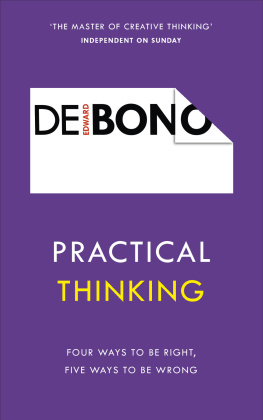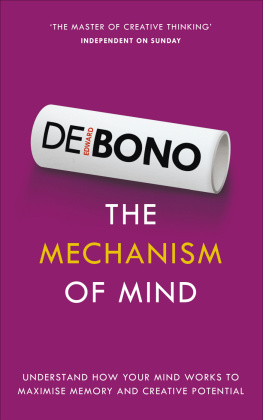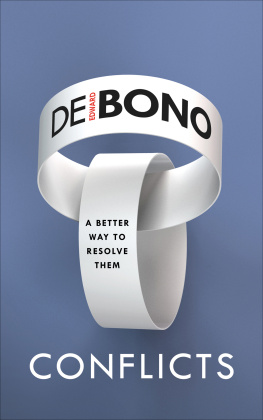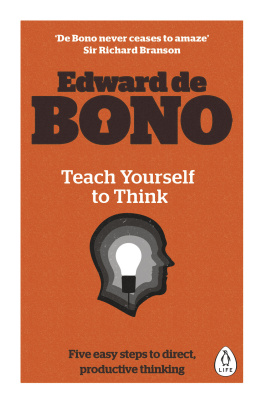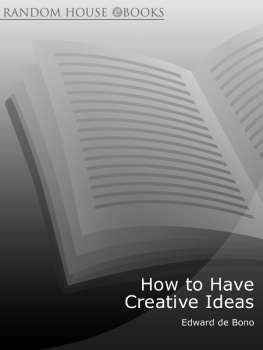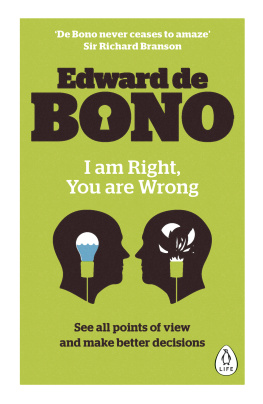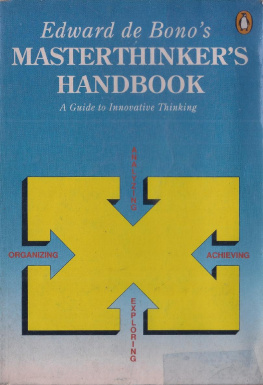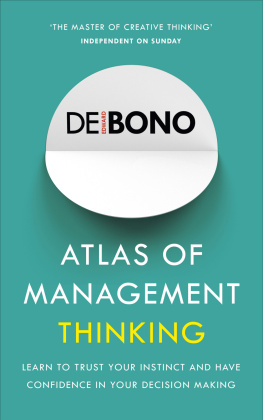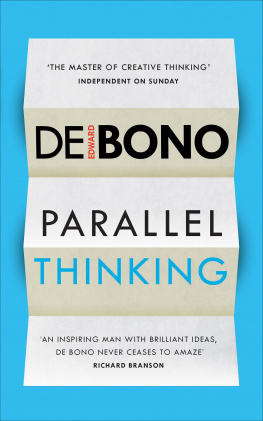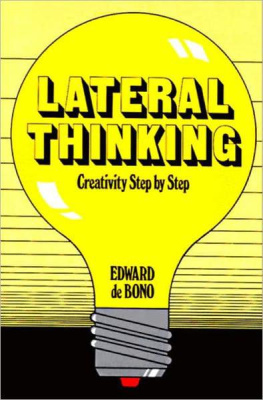CONTENTS
ABOUT THE BOOK
Mistakes and what we can learn from them are a hot topic. With Edward de Bono youll learn exactly why we all make them.
Practical Thinking is about everyday thinking how the mind actually works, not how philosophers think it should. Based on the results of his famous Black Cylinder Experiment (a critical thinking task that asks participants why they think a black cylinder falls over), de Bono explores the four practical ways of being right. From there he picks out and names the five levels of understanding and the five major mistakes in thinking.
ABOUT THE AUTHOR
Edward de Bono studied at Christ Church, Oxford (as a Rhodes Scholar). He also holds a PhD from Cambridge and an MD from the University of Malta. He has held appointments at the universities of Oxford, London, Cambridge and Harvard.
In 1967 de Bono invented the now commonly used term lateral thinking and, for many thousands, indeed millions, of people worldwide, his name has since become a symbol of creativity and new thinking. He has written numerous books, which have been translated into 34 languages, and his advice is sought by Nobel laureates and world leaders alike.
Other Titles by Vermilion
The Six Value Medals
How to have a Beautiful Mind
How to have Creative Ideas
Think!
Six Frames
Serious Creativity
Lateral Thinking
The Mechanism of Mind
H + (Plus) A New Religion?
INTRODUCTION
How is it that in a fight both sides are always right? How is it that no one ever makes a mistake on purpose but mistakes get made all the time?
Everyday thinking is what fills in the time when you are neither asleep nor dead. Just as you notice a car engine only when it is not running smoothly so you become aware of everyday thinking when it is not running smoothly. Everyday thinking is involved in family squabbles; making mayonnaise; planning a holiday; what to do about the dog when you want to go away for the weekend; thinking of an excuse for getting to work late; finding an easy way of getting through your work; educating the children; opening a bottle of beer when you have lost the opener; keeping your end up in a political argument; and possibly trying to make the world a better place to live in.
There is no law requiring one to think for oneself or to make ones own ideas. In important matters it is usually easier to accept other peoples ideas ready-made and this saves one the trouble of doing any thinking for oneself though one may still have to do it in minor matters. Often one has no choice but to accept the ideas of others because thinking things out for oneself can be so difficult. Education unfortunately provides little help in this matter. You can probably remember things you were taught at school about geography (valleys, river deltas, rice-growing countries, etc.) and about history (dates of battles, names of kings, etc.). But can you remember what you were taught about thinking? Or is thinking something that one knows all about anyway like walking or breathing?
The truth is that thinking is too important a matter to do anything about. So we have left it to the philosophers who over the ages have amused themselves with the most intricate analyses which have little relevance to everyday life. Some time ago a man, who was described as being one of the most influential philosophers of the century, died. Influential on his fellow philosophers, but hardly on anyone else. Just how much influence does logical positivism have on everyday thinking?
In everyday thinking both sides in a fight are always right. This is because being right is the feeling of being right. This is what guides your actions, not the abstract philosophical rightness of your ideas. In this book the four practical ways of being right are explored: currant cake (emotional rightness); jig-saw puzzle (logical rightness); village Venus (unique rightness); measles (recognition rightness). In addition to picking out and naming the four different ways of being right the book also picks out and names the five levels of understanding and the five major mistakes in thinking.
The purpose of picking out and naming these patterns of thinking is to make them recognizable. It then becomes possible to recognize these patterns in your own thinking and in the thinking of others. You can also talk about them in as definite a way as you might talk about a car or a hamburger. Without such named patterns thinking is vague and intangible and hence very difficult to talk about.
As soon as one can talk about thinking one is on the way to regarding it as a skill like playing tennis or cooking. Far too many people regard thinking as a matter of inborn intelligence which it is not. In my researches and experiments I have again and again come across very intelligent people who turned out to be very poor thinkers. Nor have I found that thinking skill has much to do with education, for some of the best educated people (Ph.D.s, university lecturers and professors, senior business executives, etc.) have also been poor thinkers. To regard thinking as a skill rather than as a gift is the first step towards doing something to improve that skill.
The book looks at practical everyday thinking which allows us to use something effectively without knowing all the details for instance a TV set. Other aspects of thinking explored include imagination, creativity, the YES/NO system, the deadly danger of arrogance and the huge importance of humour in thinking.
Thinking may seem to be too complex a process to be understood but the two basic steps are quite simple. The book also explains the extraordinary paradox that man may be able to think so much better than animals only because he is stupider.
In writing about thinking it is very easy to get lost in word dances with ideas chasing ideas in a confused whirl. In order to avoid this confusion the book is based on a direct experiment in thinking and not on fancy speculation. This simple experiment provides the backbone that runs through the book and keeps it from flopping into a shapeless metaphysical mess.
I really do believe that the most optimistic thing about the human race is its relative stupidity. There would be little hope if the human race was as bright as it thinks it is and still got itself into so much trouble. I believe that if we started paying attention directly to the subject of everyday thinking it would be rather more useful than shooting for the moon. At the moment, for instance, there are more professors in England concerned with Sanskrit than with thinking as a skill.
KNOWING WHAT TO DO
Instinct Learning Understanding
Thinking is that waste of time between seeing something and knowing what to do about it. The time is filled with ideas which lead on from one to another as we try and sort out the unfamiliar situation and change it into a familiar one with which we know how to cope. Later on man learns to amuse himself by fooling around with ideas for their own sake. But the basic biological purpose of thinking is to enable a living organism to survive by getting the things it needs and keeping clear of the things that are dangerous. It is a matter of knowing what to do about a situation: does one run forwards in greed or backwards in fear?
Three basic know-all processes
There are three basic processes used by living organisms to know enough about things to react to them properly.

